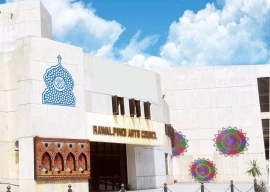
Amid the on-again, off-again diplomatic wrangling between India and Pakistan, efforts to cool off tensions through other channels have begun.
In this connection, members of civil society from both sides of the Line of Control (LoC) and Gilgit-Baltistan (G-B) are attending a 10-day intra-Kashmir conference in Cambodia.
The group of 20 eminent individuals representing diverse backgrounds such as academia, media, advocacy and development sector and drawn from both sides of LoC are currently travelling through different parts of Cambodia to learn experiences of resilience from the Cambodian people, who suffered three decades of civil war and genocide.
The study tour includes workshops, interactions with survivors and visits to exemplary civil society institutes on a short duration fellowship with Centre for Peace and Conflict Studies in Phnom Penh, a Cambodia-based NGO.
Sharing their learning after first leg of tour to Phnom Penh, the participants noted that Cambodia and Jammu and Kashmir are two entirely different stories but there are enormous commonalities of human sufferings and lessons for moving towards peaceful, progressive and pragmatic society.
“Blessed with intellect and resources we are placed way ahead of many other communities in the world but we need to learn how to make best use of our advantages to reach a peaceful resolution of Kashmir conflict – which involves the right to self-determination of the people of the disputed Himalayan state,” said one participant.
Attendees were of the view that the biggest predicament with the Kashmiris is the lack of a mutually agreed agenda between communities and regions for a shared future.
To address this critical problem, they vowed to avail every available opportunity for enhancing interactions and understandings between different communities including academics, journalists, lawyers, traders, activists of NGOs from both sides of the LoC.
Since the study tour also focuses on women’s roles in peace building, the participants regretted a near absence of women from the political processes in both sides of Kashmir.
They said that women’s participation is even more necessary as they have borne the brunt of instability, armed conflict and violence and as a result have suffered destitution and displacements.
Learning from the experiences of strife-torn Cambodia, the group also underlined the need for making concerted efforts towards reconciliation, reconstruction and a new future for the Himalayan people.
Published in The Express Tribune, March 3rd, 2012.
COMMENTS (9)
Comments are moderated and generally will be posted if they are on-topic and not abusive.
For more information, please see our Comments FAQ

1731479848-0/Elon-Musk-and-Vivek-Ramaswamy-and-Donald-Trump-(1)1731479848-0-165x106.webp)















@Deb,
Please note: 40,000 FAMILIES down to ONLY 800 FAMILIES of Christians amongst total population of six million individuals in Kashmir Valley under Indian administration. This was brought out in discussions in how to create an atmosphere conducive to return of all communities. Please refer to OUTLOOK (India) and "Saldanha" for details, and recent Christian cleansing issues for the most recent reports.
May be they can share their lessons with people in Balochistan as well.
@gt
"........from 40,000 christians to just 800".
That's a shocker! And it happend in the Kashmir valley! Shame to Govt of Jammu and Kashmir and to Govt of India. Well, I forgot Kashmir is a part of Pakistan, ideologically at least.
Will they teach Cambodian's on how to make sure only people of one faith can survive and leech of state resources while back-stabbing them in cohorts with neighboring enemy countries?
Justice Saldanha of the Mumbai High Court recently has noted with that in the last 10-20 years the number of Christian families in the Kashmir Valley has gone down from 40,000 to JUST 800! Another example of ethnic cleansing not generally made clear to the world by the votaries of the religion of peace!!
of course, the killings/ genocide of Pandits are of no consequence here.
Please don't mention G-B separately , it is a part of Kashmir , yes disputed Kashmir.
Pl visit Ankor Wat temples and write about them with photos.
So Kashmiri Hindus, sikhs, Buddhists and others also accompanied or only Muslims ?